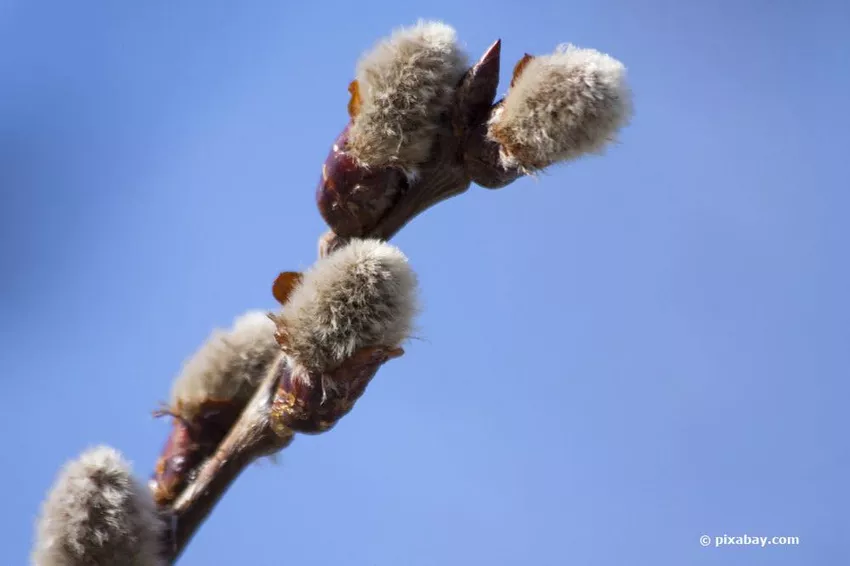
The indestructible willow plant is ideal as a hedge, but is also used in forestry as a renewable raw material. If a willow tree is to be planted in the garden, it can be produced by cuttings. These grow very quickly and can then be cultivated. The following instructions explain how best to propagate the willow plant.
increase pasture
The willow cuttings can be cut off the tree immediately. Depending on the area of application, the length may vary. Even long shoots can root quickly if they are not pure, green branches. It makes sense if the bark is already slightly woody. The best time to cut cuttings is in June or early July. The cut pieces must then be placed in water, where they quickly take root.
- Do not remove any branches of the pussy willow from nature, they are under protection
- Cut back willows after flowering for optimal branching
- You can plant the varieties of silk and arctic willow next to each other, they quickly develop into hedges
Different types of willow
There are willow species where it is sufficient if they are stuck in moist soil or wrapped with a damp cloth. However, it makes more sense to root in water so that you can see the development for yourself. The following varieties have proven to be particularly vigorous:
- purple willow, bot. Salix purpurea
- Sal willow, bot. Salix caprea
- white willow, bot. Salix alba
All these three varieties produce numerous in spring pussy willow. The roots are very branched, so they are often used to strengthen the soil when planting along the bank.
Willows are available in almost any size. There are varieties that grow over 30 meters high. To cultivate a hedge, cuttings of 20 cm in size are sufficient. After they have grown, they can be pruned in the first year, which means they branch out particularly well.
If you want to cultivate the willow as a standard, a cutting of 50 - 80 cm is required. You can also create living fences with it, the section should not be less than one meter.
use of pasture
Willow branches have a long tradition, they were even used to build houses in earlier years. Baskets have always been woven from willow branches, and this type of handicraft is still very popular today.
This is how the pollarded willow came about, because it produces numerous, long shoots from the trunk. They are an impressive sight and very easy to propagate. Whether as a property boundary or as a shade provider in your own garden, the reasonably easy-care pollarded willow is a welcome guest in the garden.
The use of willow rods:
- Willow branches are very popular as decoration, especially at Easter
- the willow rod can be used as a support rod in the garden
- thick willow rods are suitable as substitutes for posts and stems
- Willow cuttings are popular trellis structures
Grow pasture from cuttings yourself: instructions
If you want to propagate your pasture or want to grow a new plant yourself, there are a few tips you should keep in mind:
- Cut willow cuttings in summer
- Remove the branch from the tree or shrub and cut into pieces 20 cm long
- use woody branch
- Place pieces in a glass of water
- Change water every two days
- after about 14 days put the willow cuttings in normal substrate
You can decide for yourself whether you plant the willow cuttings directly in the garden or whether you choose a pot as an intermediate station. A special substrate is not required, the willow also thrives in commercially available potting soil.
 Willow, Salix
Willow, Salix
Rooted cuttings
Once you have rooted cuttings, you can use them directly in the appropriate spot in the garden. You don't need a pot for temporary storage unless you absolutely want to. The willow plant grows very quickly and soon begins to sprout.
In the first few weeks you should water occasionally, it is enough if the soil is slightly damp. In no case should it be allowed to waterlogging come, because then the newly developed roots go moldy.
Once the willow cuttings have taken root, you don't have to do anything else. The plant is frugal and will get its nutrients from the soil. Fertilizing once a year and regular pruning is also mandatory.
Unrooted cuttings
You can also stick unrooted willow cuttings directly into the appropriate substrate. To do this, stick the cut pieces into the ground until only two centimeters protrude from the ground. Water thoroughly and make sure that the soil does not dry out.
It is important that you remove weeds regularly because the willow plant needs all the nutrients for itself.
Make absolutely sure that you use the willow cuttings correctly and not the wrong way around. You have to stick the bottom end into the ground, otherwise roots will not develop. The easiest way to do this is to make sure that the underside is trimmed straight.
 Sal willow, Salix caprea
Sal willow, Salix caprea